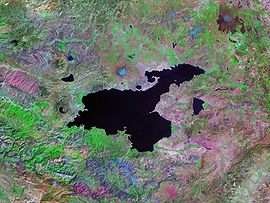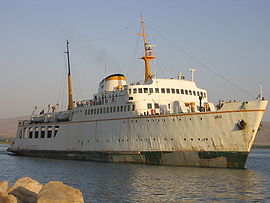This is an old revision of this page, as edited by Diyarbakir (talk | contribs) at 13:17, 4 February 2007 (Van). The present address (URL) is a permanent link to this revision, which may differ significantly from the current revision.
Revision as of 13:17, 4 February 2007 by Diyarbakir (talk | contribs) (Van)(diff) ← Previous revision | Latest revision (diff) | Newer revision → (diff) Saline lake in Turkey| Lake Van | |
|---|---|
| Coordinates | 38°38′N 42°49′E / 38.633°N 42.817°E / 38.633; 42.817 |
| Type | saline lake |
| Basin countries | Turkey |
| Surface area | 3,755 km² |
| Max. depth | 451 m |
| Surface elevation | 1719 m |

Lake Van (Template:Lang-tr; Template:Lang-hy; Template:Lang-ku) is the largest lake in Turkey, in the far east of the country. It is a saline lake of volcanic origin with no outlet, receiving water from numerous small streams that descend from the surrounding mountains. It is 119 km across at its widest point, and up to 451 meters deep. It has an area of 3,755 km² and is 1719 meters above sea level.
The lake's outlet was blocked at some time during the pleistocene, when lava flows from Nemrut volcano blocked westward outlet towards the Mus Plain. Now dormant Nemrut Dagi is close to the western shore of the lake and another dormant stratovolcano Suphan Dagi dominates the northern side of the lake. The water level of the lake has often altered dramatically: near Tatvan, Oswald (see Geology of Armenia, 1901) noted a raised beach high above the present level of the lake as well as recently drowned trees. The level of the lake rose by at least three metres during the 1990s, drowning much agricultural land, and (after a brief period of stability and then retreat) seems to be rising again.
Its water is strongly alkaline and rich in sodium carbonate and other salts, which are extracted by evaporation and used as detergents. Darekh, a species of herring caught during the spring floods, spawns near the mouths of streams feeding the lake and is the only fish that can survive in the brackish water.
The lake is surrounded by fruit and grain-growing agricultural areas.
Cultural history
The lake was the centre of Urartian kingdom from about 1000 BC and the capital of Urartu, Tushpa, was on the shore of Lake Van (on the site of the medieval castle of Van, west of Van city).
Later the land around lake was ruled by Armenians. Along with Lake Sevan in today's Armenia and Lake Urmia in today's Iran, Van was one of the three great lakes of the Armenian Kingdom, referred to as the seas of Armenia. Along its shores and on several islands (Arter, Lim, Charpanak, etc.) the remains of Armenian churches and monasteries can be found. The best preserved is the tenth-century Church of the Holy Cross located on Akdamar Island.
The Church of the Holy Cross (Armenian Սուրբխաչ, Surb Chatsch, scientific transliteration Surb xač') on Akdamar is a famous example of Armenian art, and is the remains of a monastery built by Gagik Artzruni, king of Armenia, between 915 and 921. Reliefs on the external walls represent Bible stories such as Adam and Eve, Jonah and the whale, and David and Goliath.
Other important historical sights include Van Kalesi (Castle of Van) on the Lake's eastern shore. The modern city of Van is located to the east of this castle.
The Lake Van region is also the origin of the popular Van Kedisi breed of cat, noted for among other things its unusual fascination with water (a very rare trait among cats, who generally dislike being immersed in water).
Since about 1995 there have been reported sightings of a 'Lake Van monster' about 15 metres in length named Van Canavarı. Unal Kozak, a teaching assistant at Van University, has interviewed about a thousand people who claim to have seen the monster, and has written a book on the subject. Sceptics point out that the region would benefit from tourist revenue and a hoax might attract visitors.

Railways
The railway connecting Turkey and Iran built in the 1970s uses a train ferry across Lake Van between the cities Tatvan and Van, rather than building railway tracks around the rugged shore line. Transfer from train to ship and back again limits the total carrying capacity.
See also
References
- Multiple authors (2006). "Vansee". Misplaced Pages - Die freie Enzyklopädie. Retrieved 2006-05-12.
- RJ (1997). "Sea monster or monster hoax? - June 12, 1997". CNN Interactive - World News. Retrieved 2006-05-01.
External links
- Description of Lake Van
- All About Turkey - Lake Van
- Largest known microbialites discovered in Lake Van, Turkey